Analysis of Jean Johnson's 2018/19 Tax Return: A Case Study
VerifiedAdded on 2022/10/06
|10
|2204
|23
Case Study
AI Summary
This case study analyzes Jean Johnson's 2018/19 tax return, focusing on her earnings from Koles, investment income, marriage celebrant fees, and other sources. The analysis determines which receipts constitute assessable income, including salary, unused leave payments, and benefits from employment. It examines the tax implications of gifts, gambling winnings, and property settlements. The study also considers deductions for work-related expenses, car expenses, and superannuation contributions. Finally, it calculates Jean Johnson's total assessable income, available deductions, and tax liability, including Medicare levy and franking credits. The case study applies relevant sections of the ITAA 1936 and ITAA 1997 to determine the tax impact of various financial transactions and events in Jean Johnson's life. The case study includes a detailed breakdown of the tax liability, including the impact of PAYG and franking credits, and provides references to relevant tax rulings and legislation.

TAXATION
STUDENT ID:
[Pick the date]
STUDENT ID:
[Pick the date]
Paraphrase This Document
Need a fresh take? Get an instant paraphrase of this document with our AI Paraphraser

Question 1
1) Earnings From Koles
Issue
Determine which receipts would contribute to assessable income for Jean.
Discussion
In accordance with s. 6(5) ITAA 1997, ordinary income contributes to assessable income.
One of the key sources of ordinary income is salary from employment. As a result, the salary
derived as the store manager would contribute to assessable income (Krever, 2016).
It is essential to differentiate between allowance and reimbursement as highlighted in tax
ruling TR 92/15. The former is considered as assessable income since it is not linked to the
amount that the taxpayer has spent on the concerned expenditure. As a result, it is possible
that the taxpayer derives financial benefit on account of allowance which is not possible for
reimbursement. The entertainment allowance of $ 10,000 is completely spent on clients
owing to which no financial benefit arises, thereby no impact on taxable income
(Woellner, 2014).
As per s. 83-10 ITAA 1997, receipts on account of unused annual leave payment would be
considered as assessable income. Further, in accordance with s. 83-80 ITAA 1997, any
payment on account of unused long service leave would be fully included in the assessable
income if the same is received after August 17, 1993. Considering s. 83-10 and s. 83-80, the
receipts of the leave would fully be captured in the assessable income (Deutsch et. al., 2015).
Any gift received by the taxpayer would be exempted from tax provided if satisfies the
following conditions as indicated in TR 2005/13 (Sadiq et.al., 2015).
The transfer should have actually taken place leading to ownership change.
The transfer should be voluntary without transferee asking for the same.
The transfer should be carried out without any reciprocal expectations owing to the
gift.
The transfer should be done with benefaction of transferee in mind.
With regards to the Iphone and accommodation & travel voucher, it is apparent that Jean
never asked for the same and hence it is voluntary. Further, the change in ownership has
1) Earnings From Koles
Issue
Determine which receipts would contribute to assessable income for Jean.
Discussion
In accordance with s. 6(5) ITAA 1997, ordinary income contributes to assessable income.
One of the key sources of ordinary income is salary from employment. As a result, the salary
derived as the store manager would contribute to assessable income (Krever, 2016).
It is essential to differentiate between allowance and reimbursement as highlighted in tax
ruling TR 92/15. The former is considered as assessable income since it is not linked to the
amount that the taxpayer has spent on the concerned expenditure. As a result, it is possible
that the taxpayer derives financial benefit on account of allowance which is not possible for
reimbursement. The entertainment allowance of $ 10,000 is completely spent on clients
owing to which no financial benefit arises, thereby no impact on taxable income
(Woellner, 2014).
As per s. 83-10 ITAA 1997, receipts on account of unused annual leave payment would be
considered as assessable income. Further, in accordance with s. 83-80 ITAA 1997, any
payment on account of unused long service leave would be fully included in the assessable
income if the same is received after August 17, 1993. Considering s. 83-10 and s. 83-80, the
receipts of the leave would fully be captured in the assessable income (Deutsch et. al., 2015).
Any gift received by the taxpayer would be exempted from tax provided if satisfies the
following conditions as indicated in TR 2005/13 (Sadiq et.al., 2015).
The transfer should have actually taken place leading to ownership change.
The transfer should be voluntary without transferee asking for the same.
The transfer should be carried out without any reciprocal expectations owing to the
gift.
The transfer should be done with benefaction of transferee in mind.
With regards to the Iphone and accommodation & travel voucher, it is apparent that Jean
never asked for the same and hence it is voluntary. Further, the change in ownership has
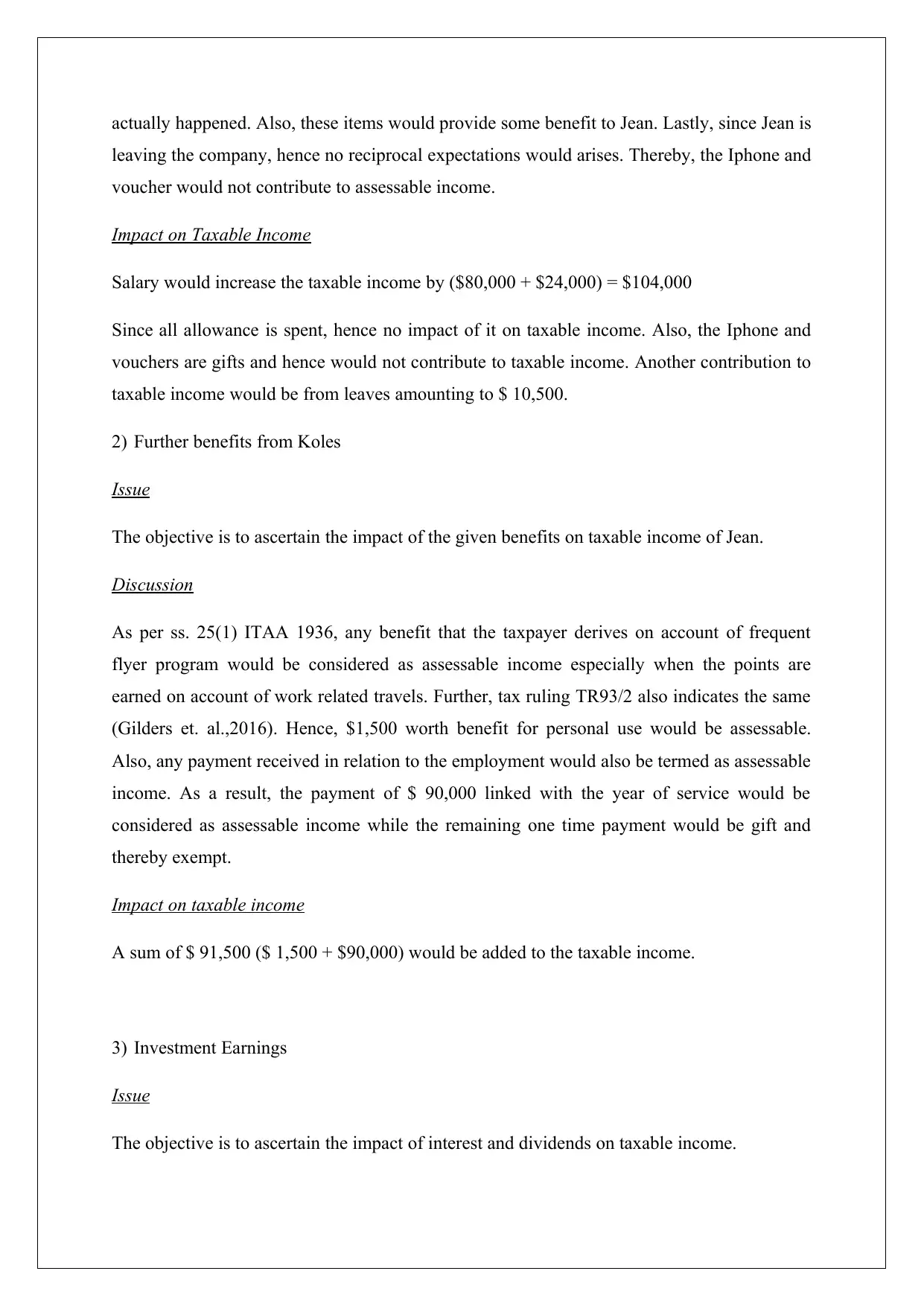
actually happened. Also, these items would provide some benefit to Jean. Lastly, since Jean is
leaving the company, hence no reciprocal expectations would arises. Thereby, the Iphone and
voucher would not contribute to assessable income.
Impact on Taxable Income
Salary would increase the taxable income by ($80,000 + $24,000) = $104,000
Since all allowance is spent, hence no impact of it on taxable income. Also, the Iphone and
vouchers are gifts and hence would not contribute to taxable income. Another contribution to
taxable income would be from leaves amounting to $ 10,500.
2) Further benefits from Koles
Issue
The objective is to ascertain the impact of the given benefits on taxable income of Jean.
Discussion
As per ss. 25(1) ITAA 1936, any benefit that the taxpayer derives on account of frequent
flyer program would be considered as assessable income especially when the points are
earned on account of work related travels. Further, tax ruling TR93/2 also indicates the same
(Gilders et. al.,2016). Hence, $1,500 worth benefit for personal use would be assessable.
Also, any payment received in relation to the employment would also be termed as assessable
income. As a result, the payment of $ 90,000 linked with the year of service would be
considered as assessable income while the remaining one time payment would be gift and
thereby exempt.
Impact on taxable income
A sum of $ 91,500 ($ 1,500 + $90,000) would be added to the taxable income.
3) Investment Earnings
Issue
The objective is to ascertain the impact of interest and dividends on taxable income.
leaving the company, hence no reciprocal expectations would arises. Thereby, the Iphone and
voucher would not contribute to assessable income.
Impact on Taxable Income
Salary would increase the taxable income by ($80,000 + $24,000) = $104,000
Since all allowance is spent, hence no impact of it on taxable income. Also, the Iphone and
vouchers are gifts and hence would not contribute to taxable income. Another contribution to
taxable income would be from leaves amounting to $ 10,500.
2) Further benefits from Koles
Issue
The objective is to ascertain the impact of the given benefits on taxable income of Jean.
Discussion
As per ss. 25(1) ITAA 1936, any benefit that the taxpayer derives on account of frequent
flyer program would be considered as assessable income especially when the points are
earned on account of work related travels. Further, tax ruling TR93/2 also indicates the same
(Gilders et. al.,2016). Hence, $1,500 worth benefit for personal use would be assessable.
Also, any payment received in relation to the employment would also be termed as assessable
income. As a result, the payment of $ 90,000 linked with the year of service would be
considered as assessable income while the remaining one time payment would be gift and
thereby exempt.
Impact on taxable income
A sum of $ 91,500 ($ 1,500 + $90,000) would be added to the taxable income.
3) Investment Earnings
Issue
The objective is to ascertain the impact of interest and dividends on taxable income.
⊘ This is a preview!⊘
Do you want full access?
Subscribe today to unlock all pages.

Trusted by 1+ million students worldwide

Discussion
As per s. 6(5) ITAA 1997, income derived from ordinary concepts is termed as ordinary
income. This would include components such as interest, rent along with dividends (Reuters,
2017). Hence, the income received as interest ($ 500) and dividends ( $14,000) would be
assessable income.
Impact on taxable income
Franking credits on dividend = [14000/(1-0.3)] -14000 = $6,000
Total contribution to taxable income = $500 (Rent) + $14,000(Dividends) + $6,000 (Franking
credits)
4) Marriage celebrant fees
Issue
It needs to be determined if the celebrant fees would be income from personal exertion.
Discussion
As per ss. 84-5 ITAA 1997, the ordinary income of the taxable would include personal
services income if it is essentially a reward for the personal efforts or skill of the taxpayer
(Barkoczy, 2017). In the given case, Jean has been given $ 200 each for the three marriages
as a reward for personal services which would contribute to ordinary income and hence
would be assessable.
Impact on taxable income
Taxable income would increase by ($200*3) = $ 600
5) Bingo Winnings and TAB account
Issue
It needs to be determined whether the bingo winnings and TAB account earnings would be
taxable or not.
As per s. 6(5) ITAA 1997, income derived from ordinary concepts is termed as ordinary
income. This would include components such as interest, rent along with dividends (Reuters,
2017). Hence, the income received as interest ($ 500) and dividends ( $14,000) would be
assessable income.
Impact on taxable income
Franking credits on dividend = [14000/(1-0.3)] -14000 = $6,000
Total contribution to taxable income = $500 (Rent) + $14,000(Dividends) + $6,000 (Franking
credits)
4) Marriage celebrant fees
Issue
It needs to be determined if the celebrant fees would be income from personal exertion.
Discussion
As per ss. 84-5 ITAA 1997, the ordinary income of the taxable would include personal
services income if it is essentially a reward for the personal efforts or skill of the taxpayer
(Barkoczy, 2017). In the given case, Jean has been given $ 200 each for the three marriages
as a reward for personal services which would contribute to ordinary income and hence
would be assessable.
Impact on taxable income
Taxable income would increase by ($200*3) = $ 600
5) Bingo Winnings and TAB account
Issue
It needs to be determined whether the bingo winnings and TAB account earnings would be
taxable or not.
Paraphrase This Document
Need a fresh take? Get an instant paraphrase of this document with our AI Paraphraser
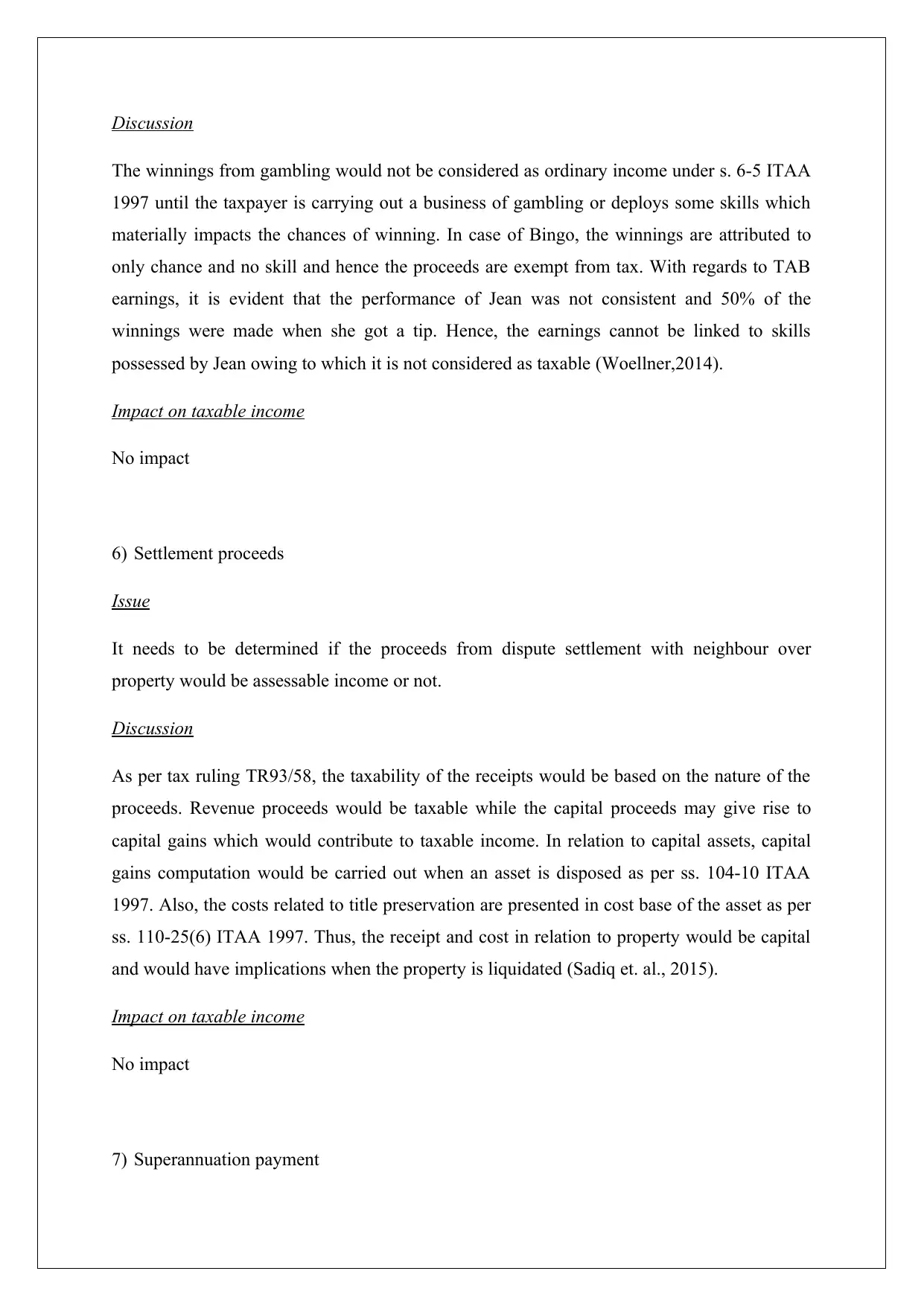
Discussion
The winnings from gambling would not be considered as ordinary income under s. 6-5 ITAA
1997 until the taxpayer is carrying out a business of gambling or deploys some skills which
materially impacts the chances of winning. In case of Bingo, the winnings are attributed to
only chance and no skill and hence the proceeds are exempt from tax. With regards to TAB
earnings, it is evident that the performance of Jean was not consistent and 50% of the
winnings were made when she got a tip. Hence, the earnings cannot be linked to skills
possessed by Jean owing to which it is not considered as taxable (Woellner,2014).
Impact on taxable income
No impact
6) Settlement proceeds
Issue
It needs to be determined if the proceeds from dispute settlement with neighbour over
property would be assessable income or not.
Discussion
As per tax ruling TR93/58, the taxability of the receipts would be based on the nature of the
proceeds. Revenue proceeds would be taxable while the capital proceeds may give rise to
capital gains which would contribute to taxable income. In relation to capital assets, capital
gains computation would be carried out when an asset is disposed as per ss. 104-10 ITAA
1997. Also, the costs related to title preservation are presented in cost base of the asset as per
ss. 110-25(6) ITAA 1997. Thus, the receipt and cost in relation to property would be capital
and would have implications when the property is liquidated (Sadiq et. al., 2015).
Impact on taxable income
No impact
7) Superannuation payment
The winnings from gambling would not be considered as ordinary income under s. 6-5 ITAA
1997 until the taxpayer is carrying out a business of gambling or deploys some skills which
materially impacts the chances of winning. In case of Bingo, the winnings are attributed to
only chance and no skill and hence the proceeds are exempt from tax. With regards to TAB
earnings, it is evident that the performance of Jean was not consistent and 50% of the
winnings were made when she got a tip. Hence, the earnings cannot be linked to skills
possessed by Jean owing to which it is not considered as taxable (Woellner,2014).
Impact on taxable income
No impact
6) Settlement proceeds
Issue
It needs to be determined if the proceeds from dispute settlement with neighbour over
property would be assessable income or not.
Discussion
As per tax ruling TR93/58, the taxability of the receipts would be based on the nature of the
proceeds. Revenue proceeds would be taxable while the capital proceeds may give rise to
capital gains which would contribute to taxable income. In relation to capital assets, capital
gains computation would be carried out when an asset is disposed as per ss. 104-10 ITAA
1997. Also, the costs related to title preservation are presented in cost base of the asset as per
ss. 110-25(6) ITAA 1997. Thus, the receipt and cost in relation to property would be capital
and would have implications when the property is liquidated (Sadiq et. al., 2015).
Impact on taxable income
No impact
7) Superannuation payment
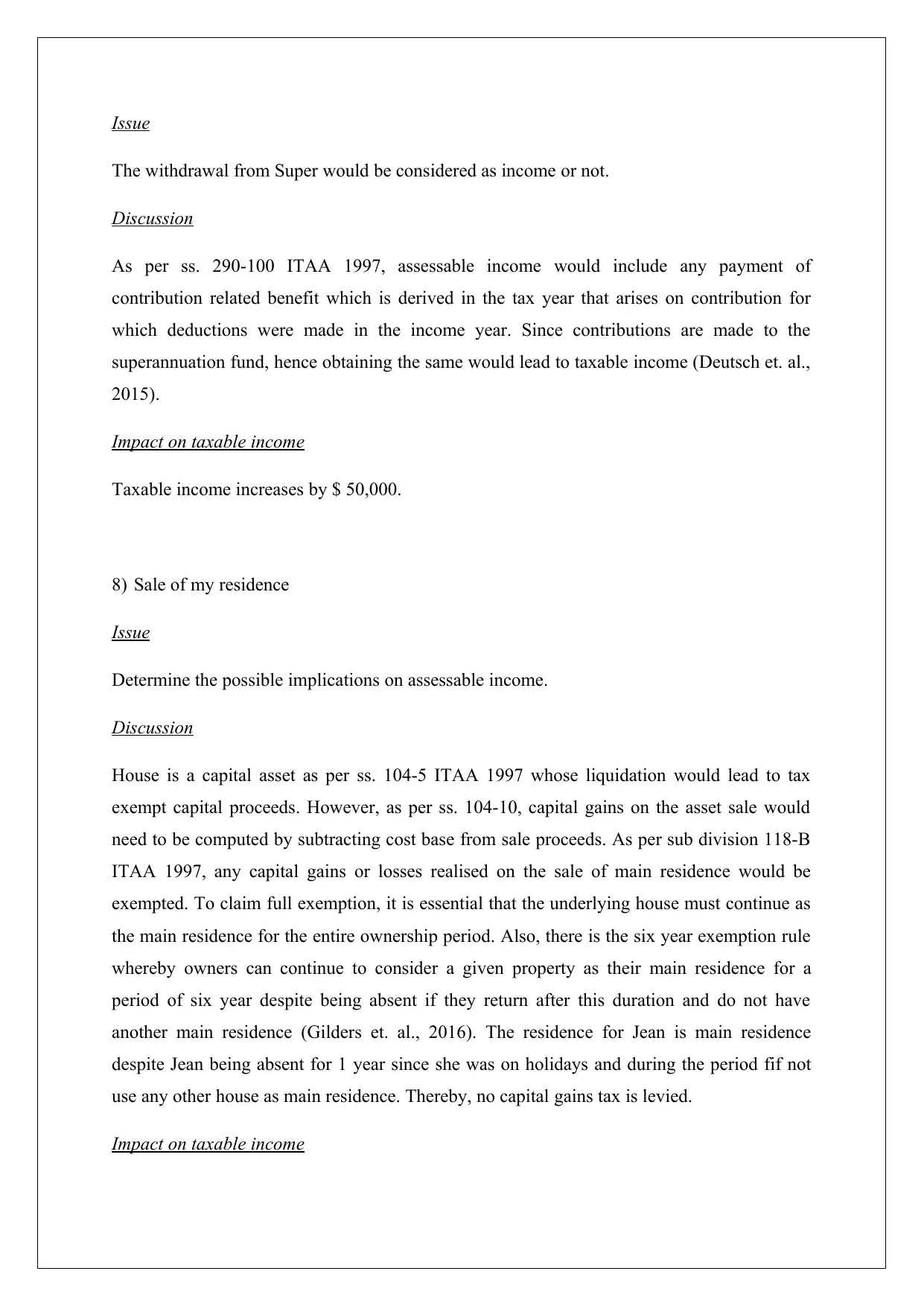
Issue
The withdrawal from Super would be considered as income or not.
Discussion
As per ss. 290-100 ITAA 1997, assessable income would include any payment of
contribution related benefit which is derived in the tax year that arises on contribution for
which deductions were made in the income year. Since contributions are made to the
superannuation fund, hence obtaining the same would lead to taxable income (Deutsch et. al.,
2015).
Impact on taxable income
Taxable income increases by $ 50,000.
8) Sale of my residence
Issue
Determine the possible implications on assessable income.
Discussion
House is a capital asset as per ss. 104-5 ITAA 1997 whose liquidation would lead to tax
exempt capital proceeds. However, as per ss. 104-10, capital gains on the asset sale would
need to be computed by subtracting cost base from sale proceeds. As per sub division 118-B
ITAA 1997, any capital gains or losses realised on the sale of main residence would be
exempted. To claim full exemption, it is essential that the underlying house must continue as
the main residence for the entire ownership period. Also, there is the six year exemption rule
whereby owners can continue to consider a given property as their main residence for a
period of six year despite being absent if they return after this duration and do not have
another main residence (Gilders et. al., 2016). The residence for Jean is main residence
despite Jean being absent for 1 year since she was on holidays and during the period fif not
use any other house as main residence. Thereby, no capital gains tax is levied.
Impact on taxable income
The withdrawal from Super would be considered as income or not.
Discussion
As per ss. 290-100 ITAA 1997, assessable income would include any payment of
contribution related benefit which is derived in the tax year that arises on contribution for
which deductions were made in the income year. Since contributions are made to the
superannuation fund, hence obtaining the same would lead to taxable income (Deutsch et. al.,
2015).
Impact on taxable income
Taxable income increases by $ 50,000.
8) Sale of my residence
Issue
Determine the possible implications on assessable income.
Discussion
House is a capital asset as per ss. 104-5 ITAA 1997 whose liquidation would lead to tax
exempt capital proceeds. However, as per ss. 104-10, capital gains on the asset sale would
need to be computed by subtracting cost base from sale proceeds. As per sub division 118-B
ITAA 1997, any capital gains or losses realised on the sale of main residence would be
exempted. To claim full exemption, it is essential that the underlying house must continue as
the main residence for the entire ownership period. Also, there is the six year exemption rule
whereby owners can continue to consider a given property as their main residence for a
period of six year despite being absent if they return after this duration and do not have
another main residence (Gilders et. al., 2016). The residence for Jean is main residence
despite Jean being absent for 1 year since she was on holidays and during the period fif not
use any other house as main residence. Thereby, no capital gains tax is levied.
Impact on taxable income
⊘ This is a preview!⊘
Do you want full access?
Subscribe today to unlock all pages.

Trusted by 1+ million students worldwide
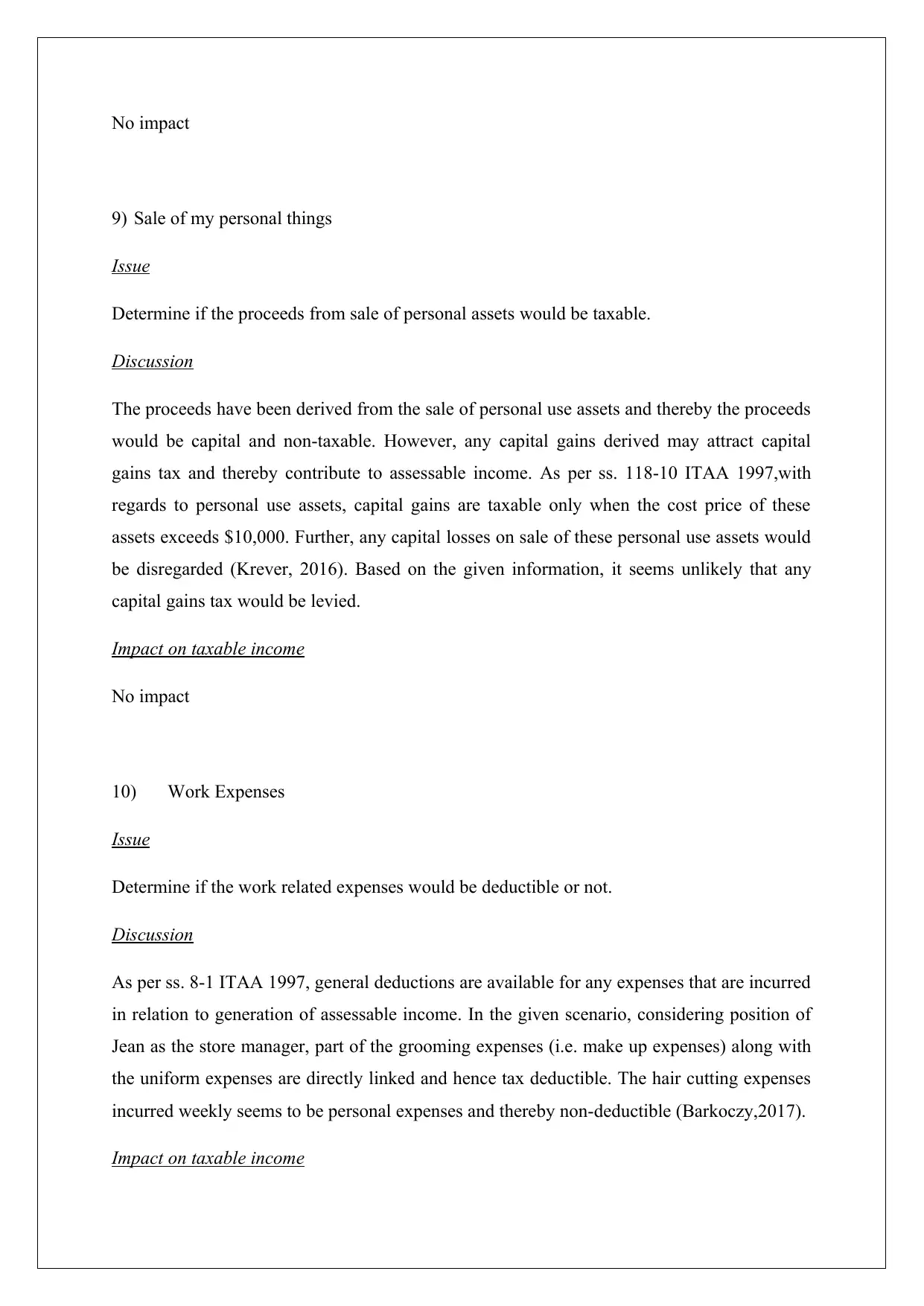
No impact
9) Sale of my personal things
Issue
Determine if the proceeds from sale of personal assets would be taxable.
Discussion
The proceeds have been derived from the sale of personal use assets and thereby the proceeds
would be capital and non-taxable. However, any capital gains derived may attract capital
gains tax and thereby contribute to assessable income. As per ss. 118-10 ITAA 1997,with
regards to personal use assets, capital gains are taxable only when the cost price of these
assets exceeds $10,000. Further, any capital losses on sale of these personal use assets would
be disregarded (Krever, 2016). Based on the given information, it seems unlikely that any
capital gains tax would be levied.
Impact on taxable income
No impact
10) Work Expenses
Issue
Determine if the work related expenses would be deductible or not.
Discussion
As per ss. 8-1 ITAA 1997, general deductions are available for any expenses that are incurred
in relation to generation of assessable income. In the given scenario, considering position of
Jean as the store manager, part of the grooming expenses (i.e. make up expenses) along with
the uniform expenses are directly linked and hence tax deductible. The hair cutting expenses
incurred weekly seems to be personal expenses and thereby non-deductible (Barkoczy,2017).
Impact on taxable income
9) Sale of my personal things
Issue
Determine if the proceeds from sale of personal assets would be taxable.
Discussion
The proceeds have been derived from the sale of personal use assets and thereby the proceeds
would be capital and non-taxable. However, any capital gains derived may attract capital
gains tax and thereby contribute to assessable income. As per ss. 118-10 ITAA 1997,with
regards to personal use assets, capital gains are taxable only when the cost price of these
assets exceeds $10,000. Further, any capital losses on sale of these personal use assets would
be disregarded (Krever, 2016). Based on the given information, it seems unlikely that any
capital gains tax would be levied.
Impact on taxable income
No impact
10) Work Expenses
Issue
Determine if the work related expenses would be deductible or not.
Discussion
As per ss. 8-1 ITAA 1997, general deductions are available for any expenses that are incurred
in relation to generation of assessable income. In the given scenario, considering position of
Jean as the store manager, part of the grooming expenses (i.e. make up expenses) along with
the uniform expenses are directly linked and hence tax deductible. The hair cutting expenses
incurred weekly seems to be personal expenses and thereby non-deductible (Barkoczy,2017).
Impact on taxable income
Paraphrase This Document
Need a fresh take? Get an instant paraphrase of this document with our AI Paraphraser

Will reduce the taxable income by $1,000 + $5,000 = $ 6,000.
11) Car Expenses
Issue
Determine the impact on the taxable income.
Discussion
The payment of running costs of the car which is for personal use would be fringe benefit and
would not have any tax implication for taxpayer Jean. The payment of $ 20,000 from the
insurance company would be capital proceeds and thus non-taxable. On the repair costs of $
2,000, 50% would be tax deductible as per s. 8-1 since 50% car use is for work purpose
(Reuters, 2017).
Impact on taxable income
Will reduce the taxable income by $ 1,000
Question 2
Computation of tax liability/(refund) for 2018/2019
Total assessable income = $104,000 + $10,500 + $91,500 + $20,500 + $ 600 + $50,000 =
$277,400
Total deductions available = $5,000 + $1,000 = $ 6,000
Net assessable income = $277,400 - $ 6,000 = $ 271,400
The applicable personal tax rates are given below.
11) Car Expenses
Issue
Determine the impact on the taxable income.
Discussion
The payment of running costs of the car which is for personal use would be fringe benefit and
would not have any tax implication for taxpayer Jean. The payment of $ 20,000 from the
insurance company would be capital proceeds and thus non-taxable. On the repair costs of $
2,000, 50% would be tax deductible as per s. 8-1 since 50% car use is for work purpose
(Reuters, 2017).
Impact on taxable income
Will reduce the taxable income by $ 1,000
Question 2
Computation of tax liability/(refund) for 2018/2019
Total assessable income = $104,000 + $10,500 + $91,500 + $20,500 + $ 600 + $50,000 =
$277,400
Total deductions available = $5,000 + $1,000 = $ 6,000
Net assessable income = $277,400 - $ 6,000 = $ 271,400
The applicable personal tax rates are given below.
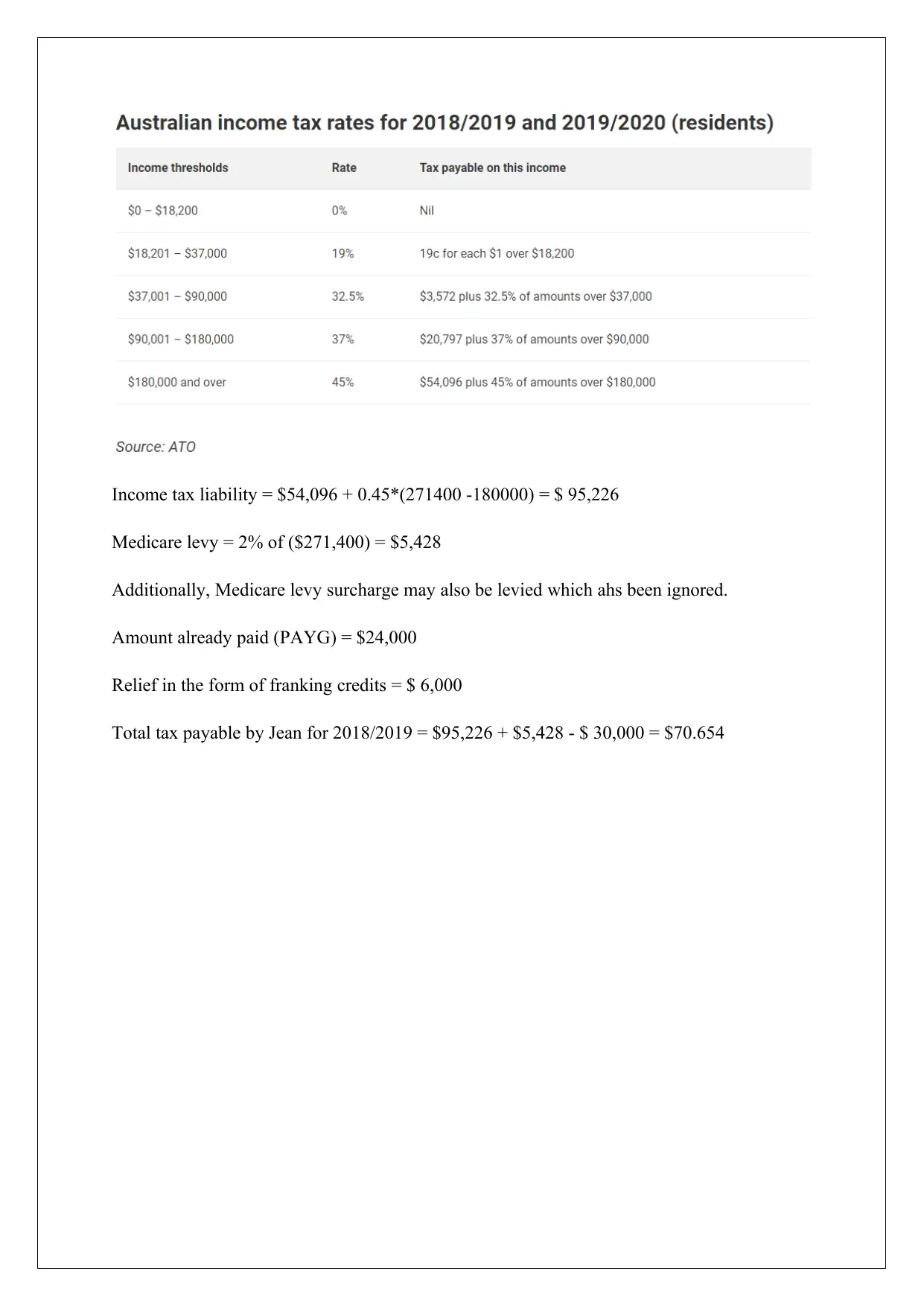
Income tax liability = $54,096 + 0.45*(271400 -180000) = $ 95,226
Medicare levy = 2% of ($271,400) = $5,428
Additionally, Medicare levy surcharge may also be levied which ahs been ignored.
Amount already paid (PAYG) = $24,000
Relief in the form of franking credits = $ 6,000
Total tax payable by Jean for 2018/2019 = $95,226 + $5,428 - $ 30,000 = $70.654
Medicare levy = 2% of ($271,400) = $5,428
Additionally, Medicare levy surcharge may also be levied which ahs been ignored.
Amount already paid (PAYG) = $24,000
Relief in the form of franking credits = $ 6,000
Total tax payable by Jean for 2018/2019 = $95,226 + $5,428 - $ 30,000 = $70.654
⊘ This is a preview!⊘
Do you want full access?
Subscribe today to unlock all pages.

Trusted by 1+ million students worldwide
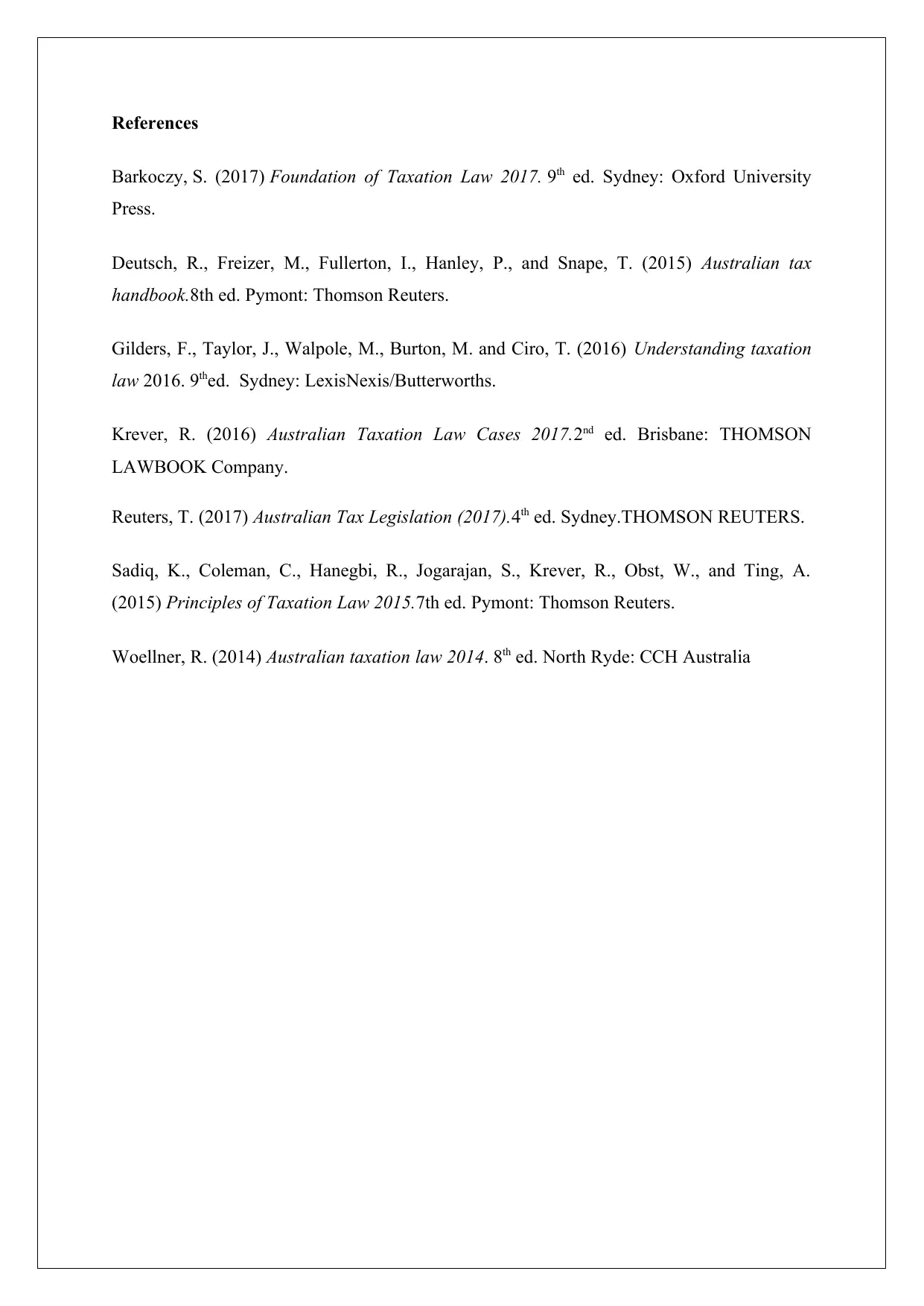
References
Barkoczy, S. (2017) Foundation of Taxation Law 2017. 9th ed. Sydney: Oxford University
Press.
Deutsch, R., Freizer, M., Fullerton, I., Hanley, P., and Snape, T. (2015) Australian tax
handbook.8th ed. Pymont: Thomson Reuters.
Gilders, F., Taylor, J., Walpole, M., Burton, M. and Ciro, T. (2016) Understanding taxation
law 2016. 9thed. Sydney: LexisNexis/Butterworths.
Krever, R. (2016) Australian Taxation Law Cases 2017.2nd ed. Brisbane: THOMSON
LAWBOOK Company.
Reuters, T. (2017) Australian Tax Legislation (2017).4th ed. Sydney.THOMSON REUTERS.
Sadiq, K., Coleman, C., Hanegbi, R., Jogarajan, S., Krever, R., Obst, W., and Ting, A.
(2015) Principles of Taxation Law 2015.7th ed. Pymont: Thomson Reuters.
Woellner, R. (2014) Australian taxation law 2014. 8th ed. North Ryde: CCH Australia
Barkoczy, S. (2017) Foundation of Taxation Law 2017. 9th ed. Sydney: Oxford University
Press.
Deutsch, R., Freizer, M., Fullerton, I., Hanley, P., and Snape, T. (2015) Australian tax
handbook.8th ed. Pymont: Thomson Reuters.
Gilders, F., Taylor, J., Walpole, M., Burton, M. and Ciro, T. (2016) Understanding taxation
law 2016. 9thed. Sydney: LexisNexis/Butterworths.
Krever, R. (2016) Australian Taxation Law Cases 2017.2nd ed. Brisbane: THOMSON
LAWBOOK Company.
Reuters, T. (2017) Australian Tax Legislation (2017).4th ed. Sydney.THOMSON REUTERS.
Sadiq, K., Coleman, C., Hanegbi, R., Jogarajan, S., Krever, R., Obst, W., and Ting, A.
(2015) Principles of Taxation Law 2015.7th ed. Pymont: Thomson Reuters.
Woellner, R. (2014) Australian taxation law 2014. 8th ed. North Ryde: CCH Australia
1 out of 10
Related Documents
Your All-in-One AI-Powered Toolkit for Academic Success.
+13062052269
info@desklib.com
Available 24*7 on WhatsApp / Email
![[object Object]](/_next/static/media/star-bottom.7253800d.svg)
Unlock your academic potential
Copyright © 2020–2025 A2Z Services. All Rights Reserved. Developed and managed by ZUCOL.





